HOW TO SUPPLY CALCIUM TO A CORAL AQUARIUM
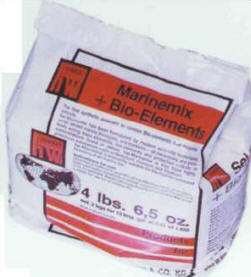
Some commercial salts are specially designed for marine
invertebrates.
Method 1
From the start, i.e. when you put the first water in, use commercial salts enriched
in calcium. Then, add the same salts over the course of regular partial water changes,
at the rate of 10% per week.
Method 2
Use commercial products specially prepared to increase calcium levels.
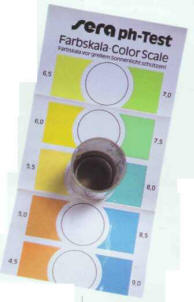
Method 3
Place a calcareous element, such as calcareous rock, or crushed and washed oyster
shells, in the filter, and this will gradually release calcium. However, this method
will not give rise to any rapid or significant increase in calcium levels.
Method 4
Prepare a solution of slaked lime, Ca (OH)2, available in aquarium stores, at
a rate of 1.5 g/liter. Pour in 1 ml of this solution per liter of sea water.
Proceed gradually, monitoring the pH constantly to ensure it does not rise above
8.5.
Method 5
This is the most complicated, but also the most effective.
Prepare two solutions:
- one of dehydrated calcium chloride (CaCI2, 2H2O) at a rate of 15 g/liter,
which will provide the calcium;
- the other of sodium bicarbonate (NaHCO3), at a rate of 17 g/liter, which
will provide the carbonates.
Then calculate the difference between a carbonate hardness of 130 ppm (7.2В°CH)
and the one measured in the aquarium. Multiply the result by the net volume of the
tank, and divide the result by 10. This will give the amount of each solution required,
in milliliters, to pour into the aquarium.
Example: for a tank with a net volume of 500 liters, with a carbonate hardness
of 100 ppm (5.6В°CH), the result is:
Amount of each solution (in ml) = 500 x (130-100) + 10 = 1,500 ml.
The following table gives you the required amount of each solution (in ml) for
specific cases.
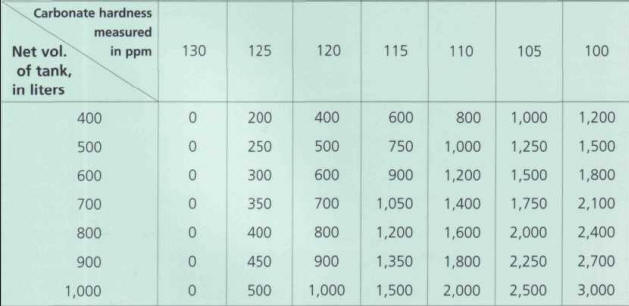
Feeding Coelenterates
By filtering the water, the Coelenterates trap small suspended particles, particularly
the crustacean zooplankton. Collecting, keeping, and distributing plankton is not
a task to be taken lightly, and it is best to look for other solutions.
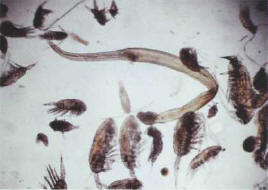
In their natural habitat, Coelenterates feed on animal plankton,
but these are difficult to supply in an aquarium.
However, it must be made clear that commercial foods on the market provide little
more than a stopgap.
It is possible to use rotifers or freshly hatched brine shrimp nauplii, normally
used as the main food for fish, but not everybody breeds these animals. There is
another food which is available to all hobbyists, as it is inexpensive, easy to
make, and can be frozen: it is usually called mussel choppy. Mussels are not only
cheap but also rich in proteins, carbohydrates, mineral salts, and vitamins. Other
possibilities are cockles, the flesh of lean fish, or cans of shelled shrimps, which
are produced in large quantities in Asia, cost little, and are readily available.
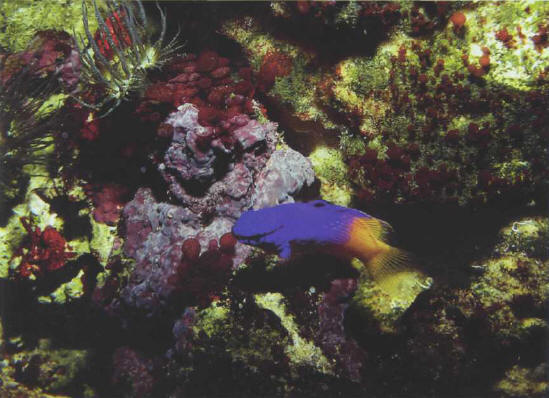
The Coelenterates can cohabit with algae - encrusting or
otherwise - and even with small fish.
The other problem is establishing a feeding schedule. It must be remembered that
the majority of organisms being fed play host to Zooxanthellae, which often satisfy
a significant proportion of their dietary needs, and so a weekly feed is more than
sufficient. Do not forget that the best time for this is the night before a water
change, to reduce the risk of pollution.
The larger anemones feed on adult brine shrimps, small pieces of mussel, fish,
or shrimps or a mixture of these.
FOOD FOR SPONGES AND COELENTERATES: A RECIPE
Ingredients:
- mussels or cockles;
- white fish, i.e. lean and free of lipids;
shelled shrimps in cans (optional). Cook the mollusks and fish. Put the shrimps
in boiling water for 1-2 minutes. Remove the mollusks' shells.
Mix all the ingredients thoroughly. You can add a vitamin solution, flakes or
granules of fish food, boiled spinach, or the special foods for invertebrates available
commercially. If the paste is too thick after mixing, thin it with sea water.
Pass the mixture through a sieve. What is left behind in the sieve can be distributed
to anemones or small fish; this puree can also be frozen. Allow the puree to stand
for several hours in the refrigerator, then discard any excess water.
The resulting paste can be used straightaway for feeding, or can be frozen. It
is best to put the food into the aquarium at night, 1 or 2 hours before switching
off the lights. Switch off the filters, pumps, and aeration for a moment. Thaw the
food, if necessary, and distribute the equivalent of one tablespoon of the prepared
liquid for every 200 liters of water. Deposit the food above the invertebrates with
a narrow, rigid tube. The filtration and aeration systems can be switched back on
a few minutes afterwards.
Compatibility between Coelenterates
Urticant (stinging) Coelenterates must be kept apart from the more delicate species:
a safety margin of 10-15 cm is often recommended. The madreporites and anemones
are among the most urticant, and they must not be put alongside a leather coral
from the Sarcophyton genus, for example. Other alternatives for a Coelenterates
tank are algae - whether encrusting or not - supported by live rocks, or even caulerpae.
Their development must be controlled so that they do not end up smothering the Anthozoa.
The introduction of certain fish is possible, even desirable, but there are cases
of classic incompatibilities (see table, page 178). Specially designed artificial
decor can be colonized quickly, depending on the organisms' rate of growth and reproduction.
This can sometimes make it difficult for even a practiced eye to spot the difference
between artificial and natural decor in an aquarium which has been in operation
for several months.
|